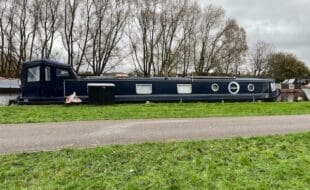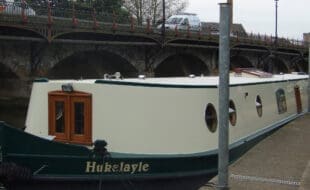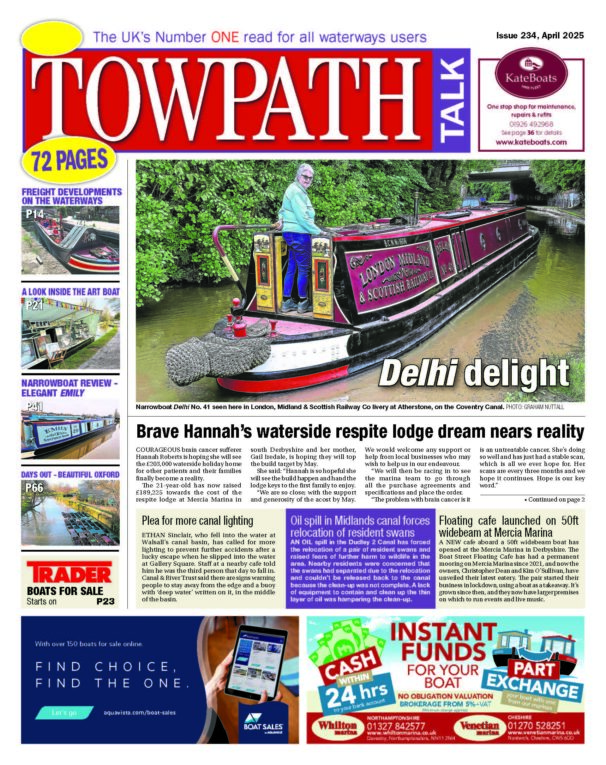Tim Coghlan reports…
THE waterside setting of the Red Wheel Plaque, awarded in 2024 to Braunston Marina by the National Transport Trust in 2024, has been enhanced as a historic canal transport hub by the placing beneath it of an old iron working boat rudder.
Its origins remain something of a mystery but various suggestions have been made since the rudder was discovered in the early 1990s half-buried among old dredgings on the northern side of the Oxford Canal Puddle Banks – just beyond Braunston Turn towards Napton Turn.

Local legend had it that the rudder came off the motor Elstree. But this is not so as the history of the Elstree – the only working narrowboat of that name in canal history – is well documented. It was built as a motor in 1935 by Harland & Wolff Ltd of North Woolwich, with a steering mechanism integral to its counter, and not outboard of its stern. The Elstree is scheduled to attend this year’s Braunston Historic Narrowboat Rally – so those who hold that belief of its long-lost rudder will be able to see the error of their ways for themselves!
Another theory was that the rudder might have been used in the various and at times exotic experiments in the late 1920s-early 1930s, to build motorised narrowboats incorporating the new diesel and semi-diesel engines, or to convert horse-drawn butties to motors. The exotic Gamecock of the late 1920s, built by Nurser Brothers at Braunston for cement carriers Charles Nelson & Co of Stockton on the Grand Union Canal, is an example of those experiments that were carried out.

Dredging hoppers
Research by canal boat historian Pete Harrison has led him to conclude the rudder was probably no more than of the type used on narrowbeam dredging hoppers from the 1930s onwards, which were built in large numbers by several fabricators including British Waterways.
They would have been similar to that on the widebeam horsedrawn barge seen here in the late 1930s photograph of the Grand Union Canal Carrying Company’s Bulls Bridge depot. That horse-drawn barge had an outboard rudder operated by a detachable tiller. (The photograph had once been in the ownership of Leslie Morton, the GUCCC’s general manager at Bulls Bridge at that time, and later with the newly founded Willow Wren yard at Braunston Bottom Lock.)
The confusion with the Elstree was that its original counter was replaced in December 1973 by the new operators of the former Willow Wren yard and the old one was unceremoniously dumped on the Puddle Banks tip, which contained not only dredgings but parts of abandoned boats. The counter was recovered some years later by Roger Fuller, who at that time owned the Elstree and operated it as a working boat on the Caldon Canal. By the time we rescued the hopper rudder, the former Elstree counter had long left the Puddle Banks.

Somehow our rudder must have come loose – maybe when the dredger was overfilled and simply turned over in heavy wind and rain in the very exposed location of the Puddle Banks, when it could have been blown against a sloping embankment. Assuming the rudder stock was poorly secured it could have just fallen off and been too heavy to recover. As a hazard to navigation, it must subsequently have been dredged out by a floating digger and dumped with the other canal dredgings. At that time the future of the canals looked pretty bleak, and no one would have thought of recovering it.
In the early 1990s, the rudder was spotted by one of Braunston Marina’s then-staff, Charlie Gamble. No one claimed it and British Waterways were happy for us to remove it. So Charlie mustered a team of heavies and a former working narrowboat with an open hold to collect it in. They managed to dig it up and bring it to the marina, where it was cleaned up and painted in its present bright colours. Two strong men were comfortably able to lift it when required in this operation but in deep water, this may not have been possible.

Local tradition
The cleaned-up rudder was originally placed on the other side of the former engine workshop to where it now is. According to local tradition, which I heard in my early days at Braunston Marina, that workshop was built by the Women’s Land Army in the Second World War. It was finished with a roof overhanging the canal arm to keep boats and workers dry when working outside.
Also in the original workshop installation was an overhead electric hoist for lifting engines in and out of engine holds and moving them into the workshop to be worked on and then put back. (Some 80 years on and the hoist is probably still in working order. It has been out of commission for several years but was still in working order when I arrived in 1988.)

The new Red Plaque Award inspired the rudder’s move to its present and hopefully permanent location. It immediately faces the old GUCCC/Willow Wren 1930s mobile crane-on-rails, which was originally at their Bulls Bridge yard in Southall and is also seen (centre) in that 1930s Bulls Bridge photograph. With the closure of nearly all BW’s canal carrying in 1963, and the surviving carrying trade being taken on by Willow Wren, the crane was disassembled and taken by narrowboat to Willow Wren’s new reduced headquarters at Braunston Bottom Lock. After the closure of Willow Wren, in about the 1970s, the crane was then dumped in the yard behind the Willow Wren workshop. It was later rescued by Braunston Marina in 1993 and moved to what is hopefully its new permanent home, where it was restored.

Also near the rudder is the 1834 Horseley Ironworks bridge, the first mass-produced iron bridge in the world. And now moored across the canal from the workshop – when not attending canal festivals – is the butty Raymond, the last wooden narrowboat ever built for the canals. This took place in 1958 in the building shed on the other side of the former engine workshop.
The rudder now forms part of Braunston Marina’s rich canal-transport heritage, well recognised by that Red Wheel Plaque award. But whether the salvaged rudder’s true origins will ever be established remains to be seen.





